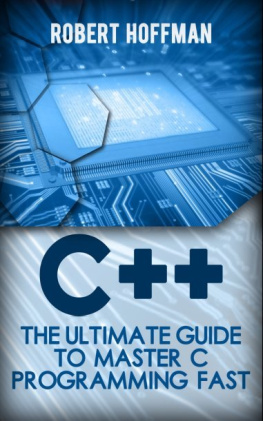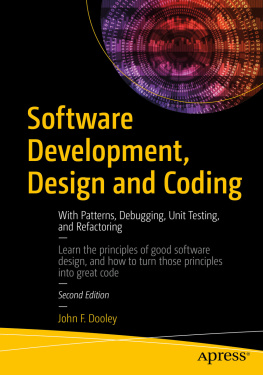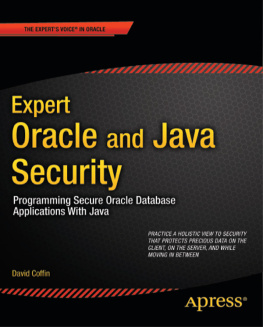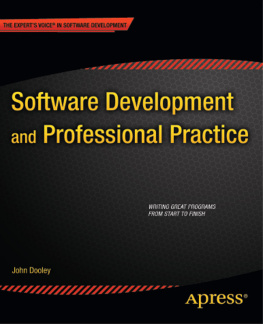The CERT Oracle Secure Coding Standard for Java
Fred Long
Dhruv Mohindra
Robert C. Seacord
Dean F. Sutherland
David Svoboda

Upper Saddle River, NJ Boston Indianapolis San Francisco
New York Toronto Montreal London Munich Paris Madrid
Capetown Sydney Tokyo Singapore Mexico City

The SEI Series in Software Engineering
Many of the designations used by manufacturers and sellers to distinguish their products are claimed as trademarks. Where those designations appear in this book, and the publisher was aware of a trademark claim, the designations have been printed with initial capital letters or in all capitals.
CMM, CMMI, Capability Maturity Model, Capability Maturity Modeling, Carnegie Mellon, CERT, and CERT Coordination Center are registered in the U.S. Patent and Trademark Office by Carnegie Mellon University.
ATAM; Architecture Tradeoff Analysis Method; CMM Integration; COTS Usage-Risk Evaluation; CURE; EPIC; Evolutionary Process for Integrating COTS Based Systems; Framework for Software Product Line Practice; IDEAL; Interim Profile; OAR; OCTAVE; Operationally Critical Threat, Asset, and Vulnerability Evaluation; Options Analysis for Reengineering; Personal Software Process; PLTP; Product Line Technical Probe; PSP; SCAMPI; SCAMPI Lead Appraiser; SCAMPI Lead Assessor; SCE; SEI; SEPG; Team Software Process; and TSP are service marks of Carnegie Mellon University.
Special permission to reproduce portions of The CERT Oracle Secure Coding Standard for Java, 20072011 by Carnegie Mellon University, in this book is granted by the Software Engineering Institute.
Many of the designations used by manufacturers and sellers to distinguish their products are claimed as trademarks. Where those designations appear in this book, and the publisher was aware of a trademark claim, the designations have been printed with initial capital letters or in all capitals.
The authors and publisher have taken care in the preparation of this book, but make no expressed or implied warranty of any kind and assume no responsibility for errors or omissions. No liability is assumed for incidental or consequential damages in connection with or arising out of the use of the information or programs contained herein.
The publisher offers excellent discounts on this book when ordered in quantity for bulk purchases or special sales, which may include electronic versions and/or custom covers and content particular to your business, training goals, marketing focus, and branding interests. For more information, please contact:
U.S. Corporate and Government Sales
(800) 382-3419
For sales outside the United States please contact:
International Sales
Visit us on the Web: informit.com/aw
Library of Congress Cataloging-in-Publication Data
The CERT Oracle secure coding standard for Java / Fred Long ... [et al.].
p. cm.(The SEI series in software engineering)
Includes bibliographical references and index.
ISBN-13: 978-0-321-80395-5 (pbk. : alk. paper)
ISBN-10: 0-321-80395-7 (pbk. : alk. paper)
1. Java (Computer program language) 2. Computer security. 3. Oracle
(Computer file) 4. Computer programmingStandards. I. Long, F. W.
(Frederick W.), 1947- II. Carnegie-Mellon University. CERT Coordination
Center.
QA76.73.J38C44 2012
005.8dc23
2011027284
Copyright 2012 Pearson Education, Inc.
All rights reserved. Printed in the United States of America. This publication is protected by copyright, and permission must be obtained from the publisher prior to any prohibited reproduction, storage in a retrieval system, or transmission in any form or by any means, electronic, mechanical, photocopying, recording, or likewise. To obtain permission to use material from this work, please submit a written request to Pearson Education, Inc., Permissions Department, One Lake Street, Upper Saddle River, New Jersey 07458, or you may fax your request to (201) 236-3290.
ISBN-13: 978-0-321-80395-5
ISBN-10: 0-321-80395-7
Text printed in the United States on recycled paper at Edwards Brothers in Ann Arbor, Michigan.
First printing, September 2011
To my late wife, Ann, for all her love, help, and support over the years.
Fred Long
To my parents Deepak and Eta Mohindra, my grandmother Shashi Mohindra, and our very peppy, spotted Dalmatian Google.
Dhruv Mohindra
To my wife, Alfie, for making this book worthwhile, and to my parents, Bill and Lois, for making it possible.
David Svoboda
To my wife, Rhonda, and our children, Chelsea and Jordan.
Robert C. Seacord
For Libby, who makes everything worthwhile.
Dean Sutherland
Foreword
James Gosling
Security in computer systems has been a serious issue for decades. This past decades explosion in the dependence on networks and the computers connected to them has raised the issue to stratospheric levels. When Java was first designed, dealing with security was a key component. And in the years since then, all of the various standard libraries, frameworks, and containers that have been built have had to deal with security too. In the Java world, security is not viewed as an add-on feature. It is a pervasive way of thinking. Those who forget to think in a secure mindset end up in trouble.
But just because the facilities are there doesnt mean that security is assured automatically. A set of standard practices has evolved over the years. The CERTOracle Secure Coding Standard for Java is a compendium of these practices. These are not theoretical research papers or product marketing blurbs. This is all serious, mission-critical, battle-tested, enterprise-scale stuff.
Preface
An essential element of secure coding in the Java programming language is a well-documented and enforceable coding standard. The CERT Oracle Secure Coding Standard for Java provides rules for secure coding in the Java programming language. The goal of these rules is to eliminate insecure coding practices that can lead to exploitable vulnerabilities. The application of the secure coding standard leads to higher quality systems that are safe, secure, reliable, dependable, robust, resilient, available, and maintainable and can be used as a metric to evaluate source code for these properties (using manual or automated processes).
This coding standard affects a wide range of software systems developed in the Java programming language.
Scope
The CERT Oracle Secure Coding Standard for Java focuses on the Java Standard Edition 6 Platform (Java SE 6) environment and includes rules for secure coding using the Java programming language and libraries. The Java Language Specification, 3rd edition [JLS 2005] prescribes the behavior of the Java programming language and served as the primary reference for the development of this standard. This coding standard also addresses new features of the Java SE 7 Platform. Primarily, these features provide alternative compliant solutions to secure coding problems that exist in both the Java SE 6 and Java SE 7 platforms.
Languages such as C and C++ allow undefined, unspecified, or implementation-defined behaviors, which can lead to vulnerabilities when a programmer makes incorrect assumptions about the underlying behavior of an API or language construct. The Java Language Specification goes further to standardize language requirements because Java is designed to be a write once, run anywhere language. Even then, certain behaviors are left to the discretion of the implementor of the Java Virtual Machine (JVM) or the Java compiler. This standard identifies such language peculiarities and demonstrates secure coding practices to avoid them.






![David Coffin [David Coffin] - Expert Oracle and Java Security: Programming Secure Oracle Database Applications with Java](/uploads/posts/book/119377/thumbs/david-coffin-david-coffin-expert-oracle-and.jpg)




